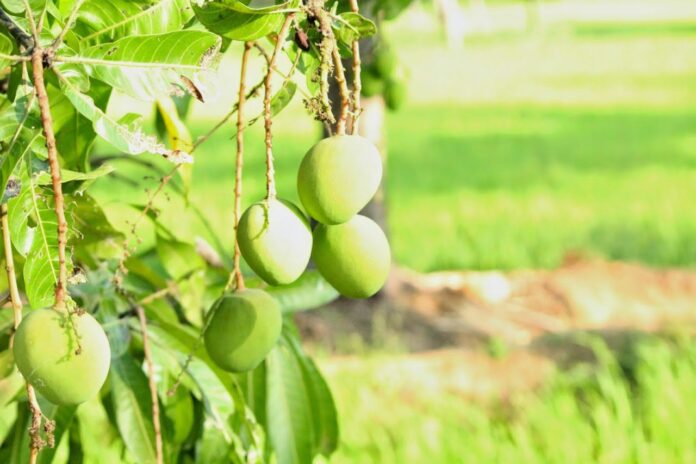Mango is cultivated as a juicy fruit; India is said to be the largest cultivator of mango in the whole world. It has been believed to be the king of fruits for a long time due to its unique taste, aroma and colour. In addition, it has the highest amount of Vitamin A. Apart from being eaten directly, mangoes are also used to make juices, jellies, jams and pickles. Mango is cultivated at an altitude of 600 metres above sea level in areas with warm and temperate climates. Therefore, there is a heavy demand for mango in the market, and it also gets reasonable prices, due to which the farmer brothers like to harvest mango.
Varieties
At present, there are widely improved varieties of mangoes, which are grown according to taste, juice and high yield. These varieties are divided into two parts:-
- Hybrid Mango
- Native Species
Suitable Soil, Climate And Temperature
For the cultivation of mango, sandy loam soil is required. Apart from this, the land should also have proper drainage. General P.H. Its cultivation can be done easily in the valued land. A warm and temperate climate is considered suitable for the mango crop. In India, it is grown during the summer season.
Mango plants need dry weather for flowering and fruit formation. Excess rainfall is not suitable for its fruits. Therefore, its plants need a 20-degree temperature to develop in the beginning, and a 27-degree temperature is required during the flowering of the plants.
Field Preparation And Fertilizer Quantity
The full-grown plant mango gives a yield of 20 years. Therefore, the field is prepared well before planting the plants in its area. First of all, the field should be well ploughed with soil-turning ploughs. After this, the field should be left open for some time. Due to this, the sun rays get better in the field’s soil. After this, get two to three slant ploughing with an Eicher 380. Due to this, the surface of the soil becomes friable. After making the soil of the field friable, put a pat in the field and get it started, due to which the field will be level, and the water-logging problem will not have to be faced.
Then, the field is levelled, one metre wide and half metre deep pits are prepared to keep a distance of 5 metres in the field for planting the plants. After this, the appropriate amount of fertilizer in these pits should be mixed with the soil and filled in the holes. After filling the soil in the pits with the Swaraj 855, they should be rinsed.
This causes the soil to decompose and become hard when the plants are planted. Prepare these pits one month before planting the plants. 25 KG old dung manure is given the proper amount of fertilizer in the holes, apart from this 150 GM as chemical fertilizer, NPK. The amount gets divided into three parts and given a year thrice. Apart from this, when the plant becomes 10 to 12 years old, the amount of chemical fertilizer is increased to 1 KG. This 1 KG quantity is given four times a year. Due to this, mango plants will grow well, and fruits will also be obtained in more amounts.
Transplanting Season And Method
Mango plants are sown in the form of seedlings. Before planting its plants in the field, a small pit is made in the prepared holes in the field. Mango plants are grown in these small pits. Before planting the plants in the pits, they are treated with appropriate amounts of cow urine or Bavistin.
The month of March is considered appropriate for transplanting its plants, but in the areas where the irrigation system is not good, its plants are planted in the rainy season in the months of June and July.
Plants Irrigation
Mango plants require more irrigation in the initial year. Its plants need 12 to 15 irrigations. Moreover, the first irrigation is given immediately after transplanting. Its plants need moisture to grow, so its plants should be kept watered. Irrigation of its plants in the summer season should be done once a week, and in the winter season, its plants have to be watered at 15 to 20 days intervals.
Weed Control
Chemical methods should not be used for weed control in mango plants. In its plants, weed control is done by natural processes. The first hoeing of its plants is done one month after transplanting. Mango plants require 8 to 10 hoeing in the initial year. After its first hoeing, the rest of the hoeing has to be done at an interval of 20 to 25 days.
Plant Diseases
Many types of diseases are also seen in mango plants, which affect the yield by destroying their plants. Plant diseases are following – internal rot, gummosis, stem borer, anthracnose, mango hopper, powdery mildew etc.
Harvesting, Yield And Benefits
The Mango plant becomes ready to give yield in 85 to 110 days. When the colour of its fruits appears yellow from above, it is plucked. After harvesting the fruits, they are washed with water and dried in a shady place. 100 to 150 kg of fruits are obtained from its fully grown plant, and about 400 plants can be planted in one acre of field, whose production can be found around 40,000 to 60,000. The market price of mango is 30 to 50 rupees per kg, so farmers can earn a good profit by earning 8 to 10 lakhs from its fully grown plants.
Stay tuned with us for more information about different farming.

